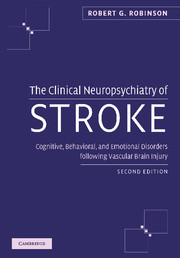 The Clinical Neuropsychiatry of Stroke
The Clinical Neuropsychiatry of Stroke Book contents
- Frontmatter
- Contents
- Preface
- Part I Introduction
- Part II Poststroke depression
- Part III Poststroke mania
- 24 Prevalence and clinical symptoms
- 25 Clinical and lesion correlates of poststroke mania
- 26 Bipolar disorder following stroke
- 27 Mechanism of mania following stroke
- 28 Treatment of mania following stroke
- Part IV Poststroke anxiety disorders
- Part V Other poststroke disorders
- Index
25 - Clinical and lesion correlates of poststroke mania
from Part III - Poststroke mania
Published online by Cambridge University Press: 01 October 2009
- Frontmatter
- Contents
- Preface
- Part I Introduction
- Part II Poststroke depression
- Part III Poststroke mania
- 24 Prevalence and clinical symptoms
- 25 Clinical and lesion correlates of poststroke mania
- 26 Bipolar disorder following stroke
- 27 Mechanism of mania following stroke
- 28 Treatment of mania following stroke
- Part IV Poststroke anxiety disorders
- Part V Other poststroke disorders
- Index
Summary
Family history
Clinical correlates of poststroke mania have not been clearly identified because of the small number of cases identified in the literature. There are several factors which have been identified in some cases but not all. We attempted to investigate clinical correlates of poststroke mania by comparing patients with secondary mania to patients with poststroke major depression or no mood disturbance following stroke (Robinson et al. 1988). The patients with secondary mania used in this study were the first 17 patients we identified with secondary mania, 9 of whom had mania following stroke. The 31 patients with major depression consisted of a consecutive series of patients with single-acute stroke lesions which preceded the onset of depression and who had no history of premorbid psychiatric disorder or other neurological or medical illness. Similarly, the group with no mood disturbance represented a consecutive series of patients examined following a single-acute stroke lesion with at least 6 months of follow-up and no prior history of neurological or physical illness. These patients had no diagnosis of mania, depression, or anxiety disorder either at the time of the acute stroke or at follow-up. The background characteristics of the three groups of patients are shown in Table 25.1.
- Type
- Chapter
- Information
- The Clinical Neuropsychiatry of StrokeCognitive, Behavioral and Emotional Disorders following Vascular Brain Injury, pp. 288 - 299Publisher: Cambridge University PressPrint publication year: 2006


